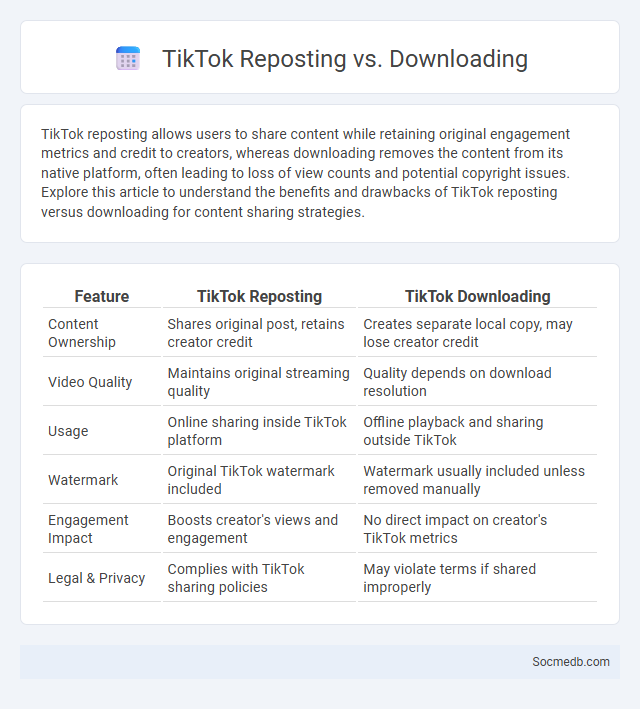
Photo illustration: TikTok Reposting vs Downloading
TikTok reposting allows users to share content while retaining original engagement metrics and credit to creators, whereas downloading removes the content from its native platform, often leading to loss of view counts and potential copyright issues. Explore this article to understand the benefits and drawbacks of TikTok reposting versus downloading for content sharing strategies.
Table of Comparison
| Feature | TikTok Reposting | TikTok Downloading |
|---|---|---|
| Content Ownership | Shares original post, retains creator credit | Creates separate local copy, may lose creator credit |
| Video Quality | Maintains original streaming quality | Quality depends on download resolution |
| Usage | Online sharing inside TikTok platform | Offline playback and sharing outside TikTok |
| Watermark | Original TikTok watermark included | Watermark usually included unless removed manually |
| Engagement Impact | Boosts creator's views and engagement | No direct impact on creator's TikTok metrics |
| Legal & Privacy | Complies with TikTok sharing policies | May violate terms if shared improperly |
Understanding TikTok Content Sharing
TikTok content sharing thrives on short, engaging videos that leverage trending sounds, hashtags, and challenges to maximize visibility and user interaction. The platform's algorithm prioritizes content with high engagement rates such as likes, comments, and shares, boosting reach across diverse demographics. Creators who tailor content to TikTok's native editing tools and community culture experience increased virality and follower growth.
What is TikTok Reposting?
TikTok reposting involves sharing existing videos on the platform to reach a broader audience without creating original content, often boosting visibility and engagement for popular clips. This practice can increase follower growth by leveraging trending videos and capitalizing on viral content dynamics inherent to TikTok's algorithm. Reposting typically requires careful consideration of copyright and attribution to maintain ethical use and comply with platform guidelines.
How TikTok Downloading Works
TikTok downloading works by allowing users to save videos directly from the app through the built-in download feature, which generates an MP4 file stored on the user's device. This process includes embedding a TikTok watermark with the creator's username to credit original content, ensuring both usability and copyright protection. Users can also utilize third-party tools and websites, although these may bypass watermarking and raise legal and ethical concerns related to content ownership.
Differences Between Reposting and Downloading
Reposting on social media involves sharing existing content directly on your profile, often crediting the original creator, which helps maintain engagement and visibility. Downloading, however, saves the content to your device for offline use or personal reference without immediate redistribution. Understanding this difference ensures your social media strategy respects intellectual property while maximizing content reach and interaction.
Pros and Cons of Reposting on TikTok
Reposting on TikTok can significantly increase content visibility and engagement by reaching broader audiences and leveraging trending topics. However, it may cause originality concerns and potential copyright infringement, risking account penalties or loss of follower trust. Balancing reposting with unique content ensures sustained growth and authentic community interaction on the platform.
Legal and Ethical Considerations
Navigating social media requires careful attention to legal and ethical considerations, including respecting intellectual property rights, ensuring privacy compliance under laws like GDPR, and avoiding defamation or harassment. Your online behavior must adhere to platform policies and local regulations to prevent legal consequences such as lawsuits or account suspensions. Understanding these responsibilities protects your reputation and fosters a trustworthy digital presence.
How to Repost Safely on TikTok
Reposting safely on TikTok involves giving proper credit to the original creator by tagging their username and avoiding content theft to respect intellectual property rights. You should always obtain permission before sharing videos that are not your own to prevent potential copyright violations or account penalties. Using TikTok's built-in repost or share features helps maintain content authenticity while protecting your account and honoring creators' efforts.
Impact on Creator Credit and Engagement
Social media platforms revolutionize how creators receive credit and engage with their audience, directly influencing their visibility and revenue potential. Algorithms prioritize content that generates high interaction, boosting likes, shares, and comments, which in turn amplify your reach and establish your authority in the niche. Proper attribution through metadata, tagging, and consistent branding ensures creators retain recognition and build lasting digital footprints essential for sustained engagement.
Best Practices for Downloading TikTok Videos
Downloading TikTok videos legally requires using the app's built-in download feature, which preserves video quality and credits the original creator. Avoid third-party software that may infringe on copyrights or compromise video quality, and always respect TikTok's community guidelines and content ownership rules. Ensuring proper attribution and obtaining creator permission enhances ethical sharing and supports TikTok's content ecosystem.
Which Method is Best for Your TikTok Strategy?
Choosing the best method for your TikTok strategy depends on your target audience, content style, and marketing goals. Using organic content creation fosters authentic engagement through trends and challenges, while paid advertising offers precise targeting and measurable ROI. Combining influencer partnerships with data-driven analytics maximizes reach and optimizes performance effectively.
 socmedb.com
socmedb.com